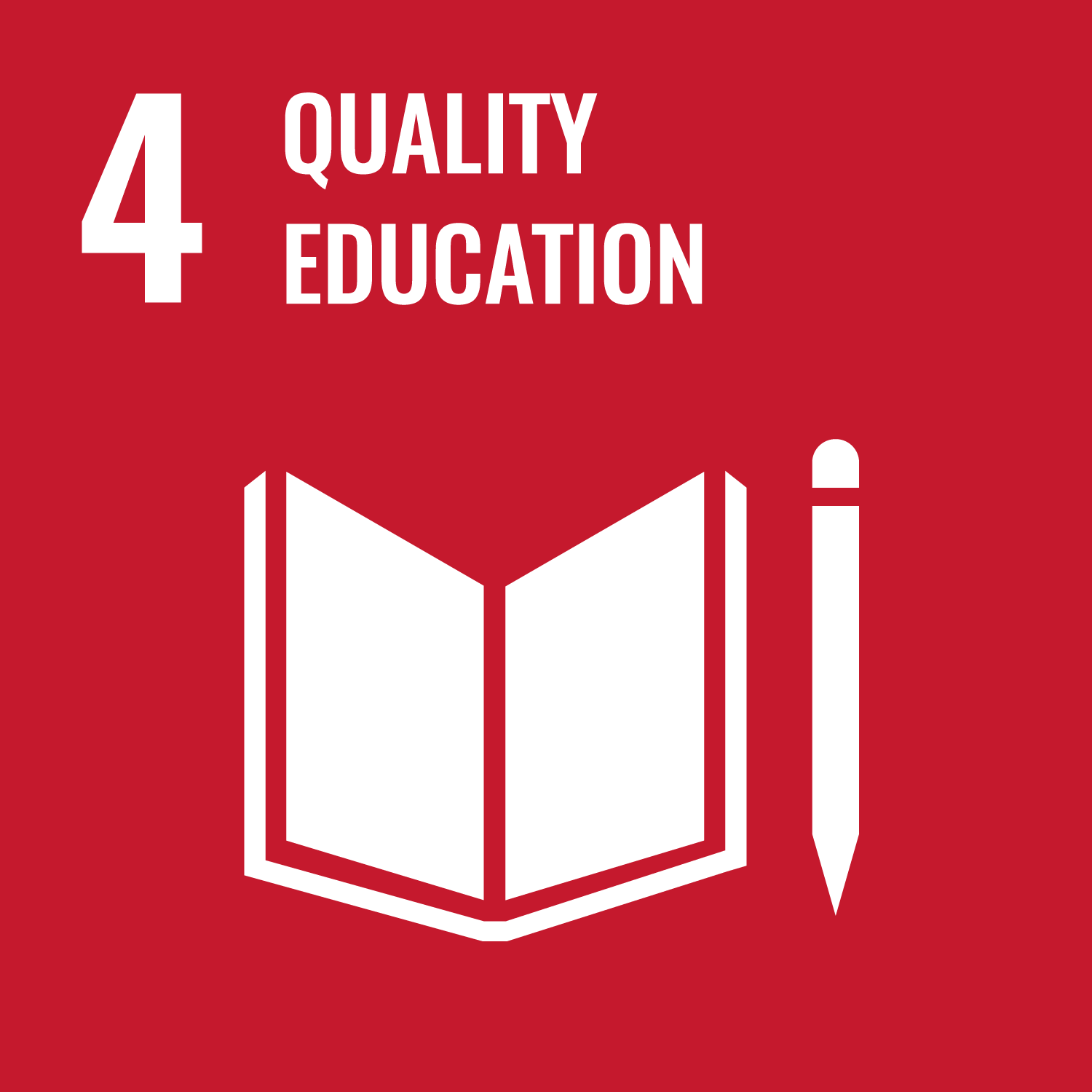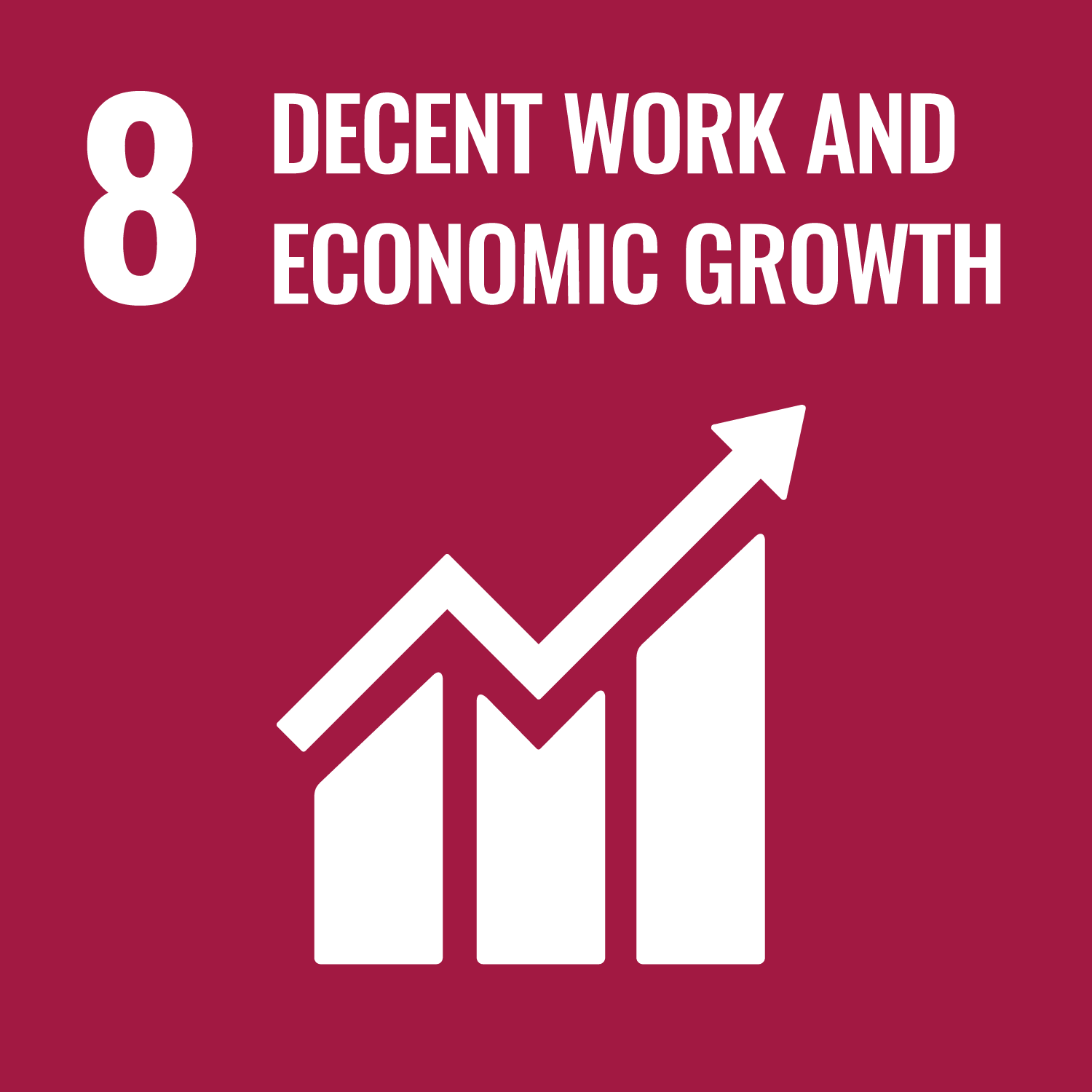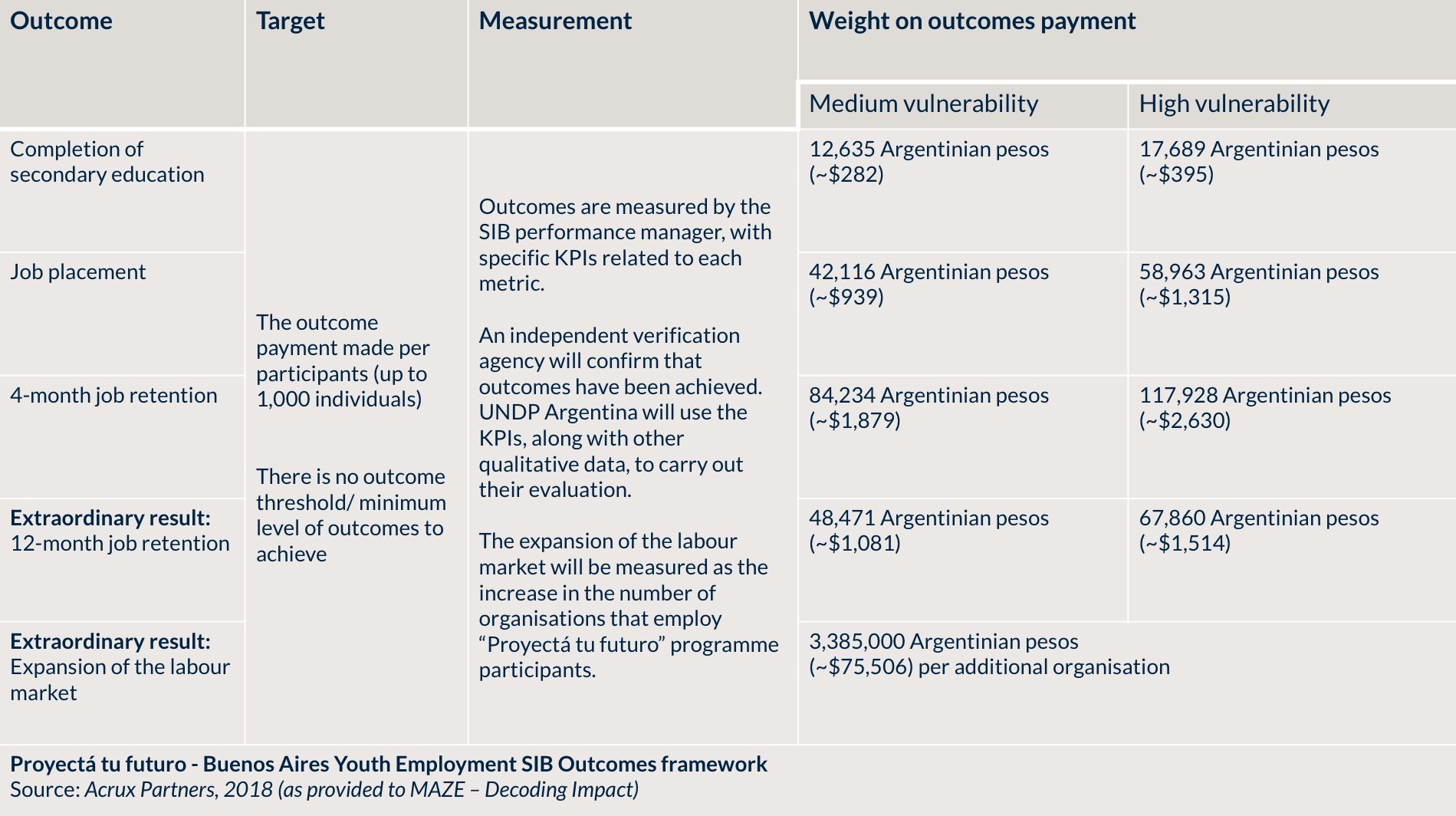
- Impact bond
- Education
- Employment and training
- South America
Buenos Aires, Argentina
6 mins
Proyectá tu futuro – Buenos Aires Youth Employment Social Impact Bond
Last updated: 10 Mar 2023
- Proyectá tu futuro – Buenos Aires Youth Employment Social Impact Bond
- SDGs and project locations
- INDIGO Key facts and figures
- Target population
- The problem
- The solution
- The impact
- Timeline
- Project insights
- Proyectá tu futuro – Buenos Aires Youth Employment Social Impact Bond
- SDGs and project locations
- INDIGO Key facts and figures
- Target population
- The problem
- The solution
- The impact
- Timeline
- Project insights
This social impact bond supported vulnerable young people in the city of Buenos Aires to access skills and employment training so that they can secure and maintain jobs.
Project Location
Aligned SDGs


INDIGO Key facts and figures
-
INDIGO project
-
Commissioner
-
Investor
-
Provider
-
Intermediary organisations
- Social Finance UK, Beccar Varela (law firm), Alimentaris
-
Performance manager
- Acrux Partners
-
Launch date
2018
-
Start of service provision
December 2018
-
Duration
3 years
-
Capital raised (minimum)
ARS 26.62m
(USD 1.10m)
-
Service users
875
Target population
Participants must meet the following criteria: (1) Ages between 17-24, (2) live in the communes 4, 7, 8, 9 or 10 of the city of Buenos Aires, (3) meet one of the following three criteria: (a) have finished high school, (b) currently coursing the last year of high school, or (c) have abandoned high school but have only 6 courses left to complete it, and (4) have no formal employment.
The problem
When the feasibility study for this SIB project was conducted, Argentina had the highest youth unemployment rate of all Latin American countries, reaching 24.7% in 2017. Youth unemployment is particularly high in the South of Buenos Aires, where the population lives in a more vulnerable context; youth there are 70% more likely to be unemployed than their peers in the rest of Buenos Aires.
Source: Acrux Partners (2018).
The solution
This social impact bond was developed to deliver skills training and employment support to vulnerable, unemployed individuals aged 17-24 living in the South of Buenos Aires.
The program, “Proyectá tu futuro”, worked with 1,000 young people who live in the five most deprived boroughs in the South of the city. It was delivered by a collaboration of four different service providers over a period of 4 to 6 months (with around 8 hours of support per week), depending on the service provider. It provided a mix of soft and technical/practical skills training, as well as mentoring for at least 6 months after the training component was completed, to help participants find and sustain a job. Achieving outcomes also required providers to work with employers to increase the number of companies that are open to hiring individuals from this societal group and foster employment.
To be eligible, individuals or their immediate family (mother, father, child), had to be in receipt of a means-tested government subsidy, or be residents of a settlement or shanty town in the selected boroughs. They couldn't have participated in another employment or skills-development government program in the 3 months prior to entering this program.

The impact
According to the final evaluation carried out by Acrux Partners, 894 young people completed their training (89% success rate comparing against initial targets), 319 young people entered the labour market (36% success rate), 242 young people maintained their jobs for 4 months (76% success rate) and 144 young people maintained their jobs for 12 months (59% success rate). The success rate for the final metric (job retention for 12 months) was actually higher than reported, but the project stopped claiming for payments for these outcomes because the contractual agreement stated that they could not account for outcomes achieved after December 2021.
Outcomes framework
The SIB aimed to improve the long-term employment outcomes of underprivileged youth living in the South of Buenos Aires. An outcomes payment card that rewards longevity in a job and differentiates payments according to the participant’s vulnerability, paying additional compensation for those individuals who are mothers or live in a settlement or shanty town, was established.
The five payable outcomes were:
- completion of secondary school, for those beneficiaries who were still enrolled in school upon entering the program;
- entry into a first job, which must be formal and pay all relevant mandatory employer contributions and taxes;
- sustained employment for 4 months;
- sustained employment for 12 months; and
- expansion of the labour market, as measured by an increase in the number of organisations that employ “Proyectá tu futuro” program participants.
Source: Acrux Partners (2018).

After the COVID-19 pandemic, all participants were considered as highly vulnerable for the project and their outcomes were paid as such.
Timeline
-
January 2017
Start of feasibility study
-
25 October 2018
Adjudication: SIB contract is awarded
-
10 December 2018
Official launch event
-
December 2018
SIB service provision starts
-
December 2020
SIB service provision ends
-
December 2021
Final impact assessment (job retention monitoring was continued until May 2022)
Project insights
Overcoming regulatory constraints and seeking legal assistance from the get-go
Legal support was paramount when it came to public advocacy in favour of the SIB and its prospective beneficiaries. Legal technical assistance helped address that challenge that the general fiscal framework in Argentina does not allow NGOs to become social investors. The Beccar Varela Law Firm, together with Acrux Partners, contacted the Argentine tax authorities and presented proposals on the income tax regulation reform, which made it clear that social impact bond investment was possible.
For the SIB financial assessment, it is necessary for the trust (SPV) to deduct expenses incurred by NGOs, which means that NGOs had to bill for services. However, the tax exemptions enjoyed by NGOs could be at risk if they have to bill the SPV for services. During the negotiation process with NGOs delivering the program, legal support and opinions were presented to assure the NGOs that by providing services and billing, their tax exemption would not be put at risk
Source: Estudio Beccar Varela, 2019.
Building relationships takes time
The legal team involved in the impact bond reinforced the importance of designing a working schedule which contemplates the necessary time to negotiate and build trust among the different parties, which are generally diverse, given their heterogeneous characteristics.
Source: Estudio Beccar Varela, 2019.
The importance of legal frameworks
It will be important to refine the technical design of future payment-by-result projects to improve the cost-effectiveness of the structuring phase. While development costs are higher in a first intervention structured as a pilot (as it is the case with Proyecta Tu Futuro), and many of their learnings and structure will be capitalised in the following interventions, other costs will continue to be high in the short term and it is important to develop strategies to reduce them and increase the scalability of the tool. A way to streamline this process would be the development of a specific legal framework for contracting by results, which would allow the different government agencies to contract with a pay-for-result scheme more easily.
Source: Acrux Partners, 2022
The need for new outcome validations methods
For the next projects, it will key to look for an alternative way of outcome validation using technological options that reduce verification times and costs.
Source: Acrux Partners, 2022
Finding new ways to align incentives of all parties
In the future, it will be important to develop strong contractual and measurement mechanisms that enable outcome payers to allocate different payment percentages to the outcome metrics, according to the level of difficulty that they present. These mechanisms should help us align the incentives of service providers, investors and outcome payers.
Source: Acrux Partners, 2022
The importance of a champion in government agencies
As demonstrated, it is very important that the area of government that is going to work with the project is involved in the development of the social impact bond, in order to promote a sense of ownership of the project. In this sense, it is necessary to first consolidate political support through the figure of a "champion" to help drive the project forward.
Source: Acrux Partners, 2022
Political context matters
It is important to be mindful of government management times and the potential influence of volatile political contexts that might extend the timelines for implementation. In such contexts, it is advisable to develop shorter projects, more adaptable to the timelines of the public sector, to make them more appealing to governments. In volatile contexts, it is recommended to prioritise pragmatism, scale and reaching the desired populations, rather than disruptions.
Source: Acrux Partners, 2022
Next steps for the ecosystem: putting the right incentives in place
Social impact bonds are an opportunity to attract private capital and invest it in the resolution of social problems. It is recommendable that the government generates the right incentives and financial guarantees to incentivise the development of new social impact bonds and the attraction of private capital from philanthropic organisations. In the case of Proyecta Tu Futuro, organisations such as foundations were exempted from being able to invest for two reasons. Investing in Proyecta Tu Futuro would mean that they were risking their tax exemption from Treasury. Additionally, the taxes associated with the structure of the investment made it very onerous for them to invest. In the future, governments should fix these issues in order to access more and more diverse sources of capital.
Source: Acrux Partners, 2022
Insights 1 and 2 are from before the end of the project. Insights 3 to 9 are from after the project completion.
Contact details
References
Communication with Flávia Tinelli, Acrux Partners, and Emilie Dussuage, Social Finance, June-July 2019.
Acrux Partners (2018) El Estado y las empresas trabajan juntos para dar solución al desempleo juvenil [Internal Memo]. Unpublished.
International Labour Organisation (2018) Panorama Laboral América Latina y Caribe 2018.
UNDP (2015) Panorama General – Informo sobre Desarollo Humano 2015.
World Bank Group (2017) Social Impact Bonds: Addressing Gaps to Solving Social Issues.
This case study was compiled by MAZE – Decoding Impact.
Page last updated: March 2023.